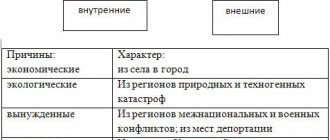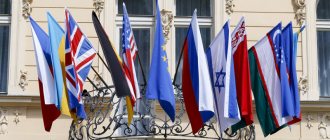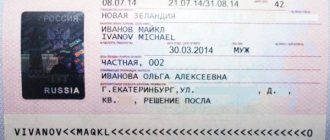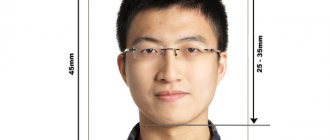Labor migration is the process of moving people or one person to different cities and countries in order to find work and further employment. Throughout the world, migration is divided into emigration and immigration. Emigration is the process of people leaving a country for the purpose of earning money in another state. Immigration is entering another country to work on its territory.
The reasons for labor migration that force people to move to another country include security of residence, the opportunity to get a good education, work in their profession and receive decent wages for it, have their own housing, social guarantees of the state (these are components of the concept of “good standard of living” ). It is precisely because it does not meet the expectations of Russians that they migrate to more economically developed countries, where the standard of living is higher.
The importance of migration of the working-age population for the economy
Important! Please keep in mind that:
- Each case is unique and individual.
- A thorough study of the issue does not always guarantee a positive outcome. It depends on many factors.
To get the most detailed advice on your issue, you just need to choose any of the options offered:
- Use the online chat in the lower corner of the screen.
- Call: Federal number: +7 (800) 511-86-74
The topic of people moving to other cities and countries in search of work is constantly raised in the media. It does not lose relevance, because this process greatly influences the development of the economy and its growth rate. Russia is an attractive destination for labor migrants, not only from the countries of the former USSR, but also from other countries. In the Russian Federation, the migration process is not as complex as, for example, in the United States, where you can come to work legally only after passing numerous checks and commissions, during which the qualifications of a specialist are established and it is determined whether such a worker is needed. People without education and not always even speaking Russian can migrate to Russia. The country receives cheap labor, and migrants improve their standard of living.
As in many other countries, the problem of labor migration in Russia is very acute. This is due to the large number of professional personnel “flowing” abroad, to be replaced by unskilled personnel from neighboring countries.
The importance of migration for the economy is as follows:
- Fight for jobs. If there are a large number of applicants for one job, competition arises, and the employer can choose a more qualified employee.
- Reduced wages. As the number of workers increases, the employer can lower wages, since there will always be an employee from a friendly state who will agree to do the same work for less money.
- Distribution of high-skilled and low-skilled workers. The wages set by the state directly affect the demand for vacancies with the appropriate level of qualifications. If the salary is decent, then there will be no shortage of specialists. Otherwise, specialists will look for better offers in other regions or abroad.
The concept and essence of labor migration
At the present stage of economic development of the world, there are trends of globalization and integration of the economic systems of individual countries.
Against this background, interaction occurs between states not only regarding finished goods and services, but also regarding factors of production. Human capital, which is represented by a workforce of various levels of qualifications and professional training, is now playing an increasingly important role in economic growth and development. Definition 1
International labor migration is a complex process of moving able-bodied citizens between states with a period of residence in a new place of more than twelve months.
Finished works on a similar topic
- Course work Migration of labor, its causes and types 480 rub.
- Abstract Labor migration, its causes and types 270 rub.
- Test work Migration of labor, its causes and types 250 rub.
Receive completed work or specialist advice on your educational project Find out the cost
The entire set of migration processes is represented in two directions:
- Emigration is leaving one's own state.
- Immigration is entry into the territory of a foreign country.
- Re-emigration is the return of previously emigrated citizens to their homeland.
We can say that migration is the import and export of human resources. The income of the “donor country” is formed from cash contributions and transfers of citizens to their relatives back home. Migration allows us to solve the issue of unemployment with a high volume of supply in the domestic market. This has a positive effect on the unemployment rate, as well as on increasing state budget revenues.
However, the outflow of highly qualified specialists affects the slowdown in economic growth, as well as the development of its priority areas.
Migration can be internal or external. The first occurs within the state, between its regions. With its help, the redistribution of human resources is carried out. External migration affects the number of citizens and affects the ratio of the number of migrants and emigrants. Currently, migration is associated with the uneven economic development of states. In developed countries, the manufacturing sector is constantly in need of additional labor, while in developing countries there is often a shortage of jobs. The territorial distribution of labor also affects migration. Most of the working-age population lives in Asia and Africa.
Do you need to select material for your study work? Ask a question to the teacher and get an answer in 15 minutes! Ask a Question
Pros and cons of labor migration
Migration is an important part of countries' economies. It has pros and cons. They are discussed in the following table.
| Advantages | Flaws |
| Attracting personnel from abroad. | Loss of a certain number of vacancies by Russia’s own citizens. |
| Interaction of cultures of different countries. | Reduction in wage level. |
| Development of the country's economy as a whole. | Criminalization of the situation due to the illegal actions of illegal migrants. |
Important! Legislation usually protects the interests of its citizens in the field of labor, so some areas are closed to foreign workers (for example, the field of national security). But where cheap unskilled labor is required, employers prefer to hire foreigners.
Labor migration at the international level
Currently, in 2021, the situation in the world is such that foreign countries are in dire need of qualified personnel. They provide benefits for talented youth to receive a quality education, a good start to work and wages that attract Russian youth. As a result, there is an outflow from the Russian Federation of young scientists, talented high school students and students, middle-aged people - professionals in their fields.
This causes a shortage of qualified personnel with higher professional education in the Russian Federation. The migration flow to Russia comes from the former allied countries. Most of them represent a low-skilled workforce. Migrants occupy low-paid jobs. Because of this situation, Russian citizens who have blue-collar professions have to either remain unemployed or accept low wages, since the employer would rather hire a person who needs to be paid less, even if he is a migrant. The following picture gives a general idea of international migration.
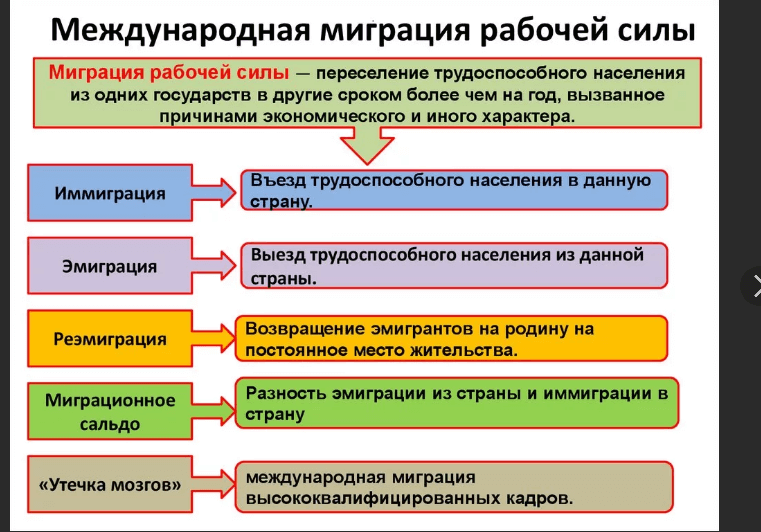
International labor migration has the goal of crossing the border of one’s own and another state to enter into labor relations with foreign employers. This is a natural process as people are constantly looking for ways to improve the quality of their lives.
The situation in the Russian Federation
Some regions of Russia are so attractive to visiting citizens that it worries demographers. For Russia, donor countries in the supply of labor are Tajikistan, Uzbekistan, Moldova, and Ukraine.
Large cities, primarily both capitals of the Russian Federation, are traditionally attractive for migrants from the Russian Federation itself. Skilled and unskilled workers flock here in search of a better life. Donors are other regions of Russia in which there is a difficult economic, political, and in some cases, natural and climatic situation.
Note! Legal regulation of internal migration processes is carried out by the Ministry of Labor and Social Development of the Russian Federation.
The tasks of the ministry are:
- attraction and distribution of migrants to jobs;
- distribution of quotas;
- assessment of migrant labor.
Every year, amendments to legislation are adopted so that the situation with migrants does not lead to a deterioration in crime statistics and the economic situation.
Important! The hiring of foreign migrants should be carried out taking into account quotas and numbers. The regulatory document for protecting the rights of labor migrants today is Order of the Russian Federation No. 2 of 01/09/2018. “On approval of the list of professions to attract foreign employees arriving in Russia.” It contains information about industries in which migrants can work. Quota jobs are distributed in such a way that the rights of Russian citizens are not infringed.
The migration service must perform the following functions:
- permit or prohibit the entry of migrants into the territory of the Russian Federation;
- cancel visas;
- in case of violation of migration legislation, bring migrants to justice before the law, and in more complex cases, expel or deport them to their homeland.
Different types of classification
The traditional division of labor migration involves distinguishing between internal and external migration. The first type involves crossing borders within one country between administrative regions and populated areas. The second type is traveling beyond the state borders of the country. In turn, external migration is intercontinental and intracontinental.
>> Meritocracy as a socio-political ideology. Meritocratic model of society
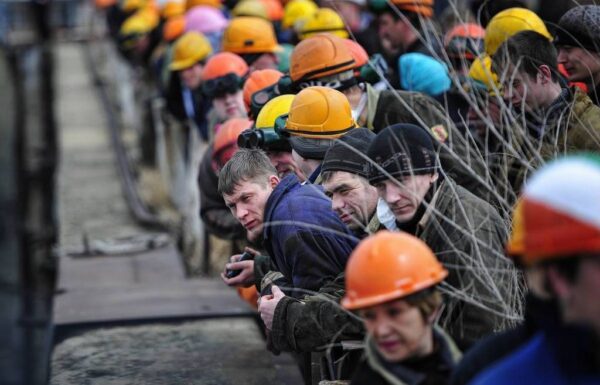
Other classifications:
- According to the time spent at a new place of residence or work: permanent and temporary, which can be short-term (up to 3 months) and long-term (from 3 months to 1 year).
- In turn, short-term migration is divided into regular and irregular. Regular means pendulum, cross-border and rotational movements of the population. Irregular – seasonal and shuttle migrants.
- By the will of the subject of displacement: voluntary and forced.
- For reasons: socio-economic, socio-cultural, environmental, natural-climatic, housing, political.
- According to legality and legitimacy: legal and illegal.
- Depending on the degree of state regulation: unregulated and regulated (the state takes an active part in the forms of migration and its stimulation).
- By structural characteristics: age, gender, ethnicity and nationality, education, qualifications, time of move, place of birth, citizenship.
- By skill level: movements of skilled and unskilled labor.
- According to economic feasibility: beneficial for the country or employee.
- By the nature of the movement of migrants: organized and spontaneous.
- By type of employer: legal entity or individual.
- By main migration centers: Western Europe region; USA, oil-producing countries of the Persian Gulf.
Often, economists and labor market researchers consider all or most of the signs of population movement in a comprehensive manner, which helps to create a more complete picture of migration processes and the structure of subjects who move.
Types of labor migration
Migration of the working-age population can be external and internal. External migration involves the movement of the working-age population from country to country. That is, it enters and exits across the borders of its own and other states. The following picture clearly shows the types of labor migration.

External labor migration in Russia and other countries has its own forms and is divided depending on the frequency of working-age citizens being outside Russia into:
- Temporary. Involves working outside the Russian Federation for no more than 6 years.
- Constant. Involves moving to a foreign country for employment.
Employment abroad involves a certain procedure, which includes:
- provision of a package of necessary documents with the mandatory formulation of the grounds for relocation;
- obtaining a labor patent, residence permit, medical insurance.
Internal labor migration in the Russian Federation and other countries involves the movement of people of working age throughout the constituent entities of Russia for the purpose of employment. This is due to the different situation in cities, namely the level of unemployment, shortage or surplus of jobs requiring low or, conversely, high qualifications, with average wages.
Due to the desire to improve the quality of their lives, people may travel to another city or even country every day (if their place of residence is near the border), or only at certain times of the year. Therefore, there are types of labor migration (seasonal, pendulum).
Types of migrants
At the international organization on migration processes, experts have identified the main types of migrants.
Illegals
This category of people looking for work, but entering the country where they intend to find work, without the appropriate permission, without paperwork, that is, illegally. This category also includes persons with an expired visa, labor patent and without a work license. The largest number of illegal immigrants was recorded in the United States, whose number in 2021 exceeded 3 million people.
Settlers
This is a category of people who go abroad not only for employment, but also for permanent residence with further registration of all documents, including citizenship of another state. Russian citizens most often emigrate to developed countries with a good standard of living and well-paid jobs. Traditionally, these are Canada, USA, Germany, Finland, Sweden.
Employees by appointment
Persons included in this group travel to another country for a certain period of time, which is specified in the contract. After fulfilling their work obligations, they return to their country. This category of persons also includes seasonal workers who work in the tourism, construction, and catering sectors.
Highly professional specialists
These are employees of large corporations, specialists with rich practical experience in a certain field, with higher education. Usually they migrate in order to pass on their experience to younger colleagues and improve their skill level in a new place. This group of people includes professors, teachers, and doctors.
Refugees
These are persons forced to look for a new place of residence due to a life- and health-threatening situation in their homeland. Migrants submit an application to the embassy of another country asking for asylum. If accepted, the person officially receives permission to work.
Main categories of labor migrants
UN experts divide all foreigners who are looking for work abroad into several groups:
- Persons who have received the right of entry to study at a university, college, school or to undergo the training process at professional courses, trainings, seminars.
- Migrant workers (the main goal is to carry out labor activities).
- Foreigners who have received permanent residence.
- Migrants moving for the purpose of uniting a family or creating a new family.
- Refugees, persons who are granted temporary asylum.
- Illegal entrants.
Immigrants and non-immigrants are allowed into the country legally. The governments of many countries are specifically developing programs to attract highly skilled and qualified workers from abroad. For example, similar opportunities are provided by Canada, Great Britain, Germany, the United States of America, France, Denmark, Sweden, and Switzerland. Legal migration involves the conclusion of a contract between the employer and the employee.

Illegal immigrants cross the border with expired visas and documents that do not allow entry at all. The number of illegal immigrants is constantly growing every year, which is associated with conflicts in the Middle East and poverty in Africa and Asia. Such migrants fill jobs that do not require education, qualifications, special skills or language.
>> Nationalism as a socio-political ideology. History, main types and features of nationalism
The number of people seeking asylum is constantly growing. The main reasons are the war in Syria, the activities of ISIS, terrorism, persecution for ethnic, racial and religious reasons, and political motives. At the end of the 1990s, the number of people seeking and receiving asylum exceeded 1 million. Over the past 20 years, there have been 80 million refugees, most of them applying for permanent residence due to threats to life in their country of former residence.
What changes await labor migration in the future?
The President of the Russian Federation approved the Concept of Migration Policy for 2019-2025. It is aimed at creating favorable conditions for people who left Russia and want to return. The concept notes that the main source of replenishment of Russia’s labor resources should remain the population of its country.
Particular attention is paid to adjusting the conditions for voluntary migration of sought-after specialists. They will be attracted intensely. The state plans to support those Russian organizations that will attract such people.
On November 15, 2021, the head of the Government of the Russian Federation signed a decree defining the quota for issuing temporary residence permits to immigrants in the Russian Federation in 2021. According to it, in 2019 it is planned to issue 83,480 permits with their distribution among the constituent entities of the Russian Federation.
Also in 2021, a regulation on the share of foreign workers in certain fields of activity will come into force. The full list can be found here. In some economic areas, the number of foreign workers will be reduced (this applies in particular to the transport sector); in others, the percentage of jobs for immigrants and Russians will remain at the same level.
The resolution does not contradict the law. According to the Federal Law “On the Legal Status of Foreign Citizens in the Russian Federation,” every year the government sets the share of foreign workers in various sectors of the economy, taking into account the characteristics of the market in each subject of the Russian Federation and the need to provide jobs for Russians in the first place.
How many labor migrants are there in Russia now?
Until March 30, 2021, entry into the country was open. The Ministry of Internal Affairs attempted to count the number of legal migrants stuck in the Russian Federation in April. We counted according to existing patents - it came out to 2.5 million. Of them:
- citizens of Ukraine - 89.2 thousand,
- citizens of Tajikistan - 507 thousand,
- citizens of Uzbekistan - 1 million 14.5 thousand.
It turned out to be more difficult with citizens of Kyrgyzstan - after all, they do not need patents. But judging by the notifications and contracts from employers of Kyrgyz citizens in the Russian Federation at that time there were 353.2 thousand.
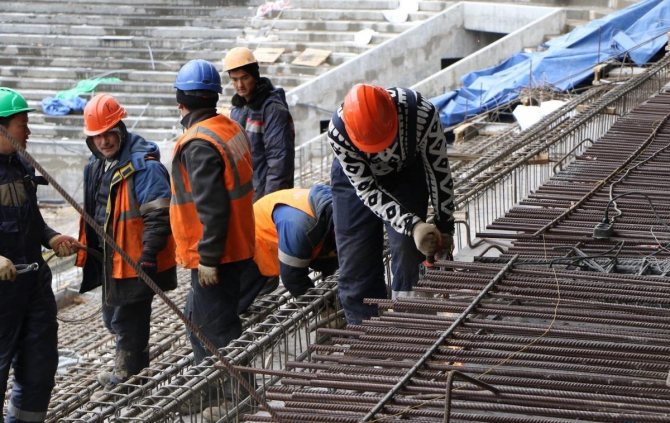
In the construction field, foreign workers can make up up to 80% of an organization's total employees. PHOTO: nn.ru
However, this information cannot be considered complete. According to updated data from the Ministry of Internal Affairs of the Russian Federation, for the period from January to June of this year, 5,328,887 people were registered for migration in the country. And half a million less were deregistered - 4,758,553. At the same time, 1,534,429 people indicated work for entry purposes, 649,145 received patents (for comparison: in the same period last year, 1,024,451 foreigners received patents), and work permits — 24,862 (compared to 60,082 in 2021).
In addition, to the total number of migrants we can add those who have been living here for several years under a temporary residence permit - 338,499. A residence permit almost equates the legal status of foreigners with Russians, but, in general, they can also be classified as migrants. There are 620,974 people with a residence permit for January-June 2021 in Russia.
- Migrants in Russia
Putin’s new Decree for migrants: residence permits, temporary residence permits, registrations were “frozen” until September 15, and work without a patent was prohibited
- Elena Voropaeva
- 15.06.2020
After the borders were closed, Russian President Vladimir Putin signed Decree No. 274 and Decree No. 392 concerning the rights of foreigners remaining in Russia. The first of them extended the validity of registrations, patents, temporary residence permits and residence permits, the terms of which were expiring, until June 15. The second decree made adjustments to this date, extending it until September 15, but clarifying that patents still need to be renewed. For some foreigners, this news was a real blessing. However, it did not make things any easier for those who lost their homes and jobs. A tent camp in the Samara region, founded by citizens of Uzbekistan, Kyrgyzstan and Tajikistan who tried to return home through Kazakhstan, is just one piece of evidence. The authorities of the republics tried to organize transport corridors from May to August. According to media reports, since the beginning of the pandemic the following have returned to their homeland:
- to Moldova - over 400 thousand people.
- in Uzbekistan - about 498 thousand people.
- There are about 90 thousand people in Tajikistan.
- to Kyrgyzstan - over 20 thousand people.

